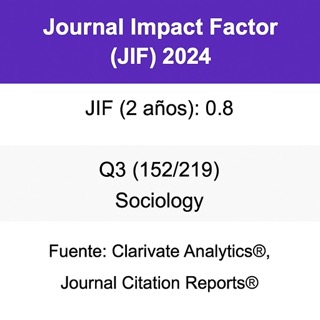Doble invisibilidad: los efectos del paro oculto en los colectivos vulnerables de población de los países del sur de Europa durante la pandemia del COVID-19
DOI:
https://doi.org/10.22325/fes/res.2022.132Palabras clave:
Labour market, Hidden unemployment, Southern European countries, COVID-19 crisis, Vulnerable populationsResumen
La crisis de la COVID-19 se ha caracterizado por una mayor fragilidad del mercado laboral, especialmente en los países del sur de Europa. Sin embargo, los datos oficiales no reflejan con exactitud las transformaciones reales de sus mercados de trabajo. En este contexto, este trabajo compara el comportamiento del mercado laboral de los colectivos vulnerables de población (jóvenes, mujeres e inmigrantes) en tres países del sur de Europa con un análisis cruzado de datos a lo largo del tiempo. Para ello, hemos desarrollado un indicador alternativo de paro oculto que recupera e incluye a los desempleados de las categorías de subempleo involuntario e inactividad. Nuestros análisis incluyen datos de España, Portugal e Italia, y toman como base la encuesta European Union-Labour Force Survey (EU-LFS). Nuestros resultados muestran que el impacto del desempleo en el sur de Europa se mide mejor cuando se utiliza un indicador ampliado, especialmente cuando se analizan los casos de colectivos vulnerables. Esta herramienta muestra un gran potencial analítico para desvelar el desempleo oculto en el contexto de la pandemia COVID-19.
Citas
Alon, T., Doepke, M., Olmstead-Rumsey, J., & Tertilt, M. (2020). This time it’s different: The role of women’s employment in a pandemic recession. Centre for Economic Policy Research (CEPR) Discussion Paper, 15149. https://doi.org/10.3386/w27660
Azmat, G., Güell, M., & Manning, A. (2006). Gender gaps in unemployment rates in OECD countries. Journal of Labor Economics, 24(1), 1-37. https://doi.org/10.1086/497817
Baert, S. (2020). The iceberg decomposition: A parsimonious way to map the health of labour markets. Economic Analysis and Policy, 69(1), 350-365. https://doi.org/10.1016/j.eap.2020.12.012
Balakrishnan, R., Dao, M., Solé, J., & Zook, J. (2015). Lost workers: Reversing the decline in U.S. labor force participation is essential to boosting growth in the world’s largest economy. Finance and Development, 52 , 36-39. https://doi.org/10.5089/9781484372500.022
Bardhan, A., & Tang, J. (2010). What Kind of Job is Safer? A Note on Occupational Vulnerability. The B.E. Journal of Economic Analysis & Policy, 10(1). https://doi.org/10.2202/1935-1682.2299
Barrett, S. R. F. (2004). Beyond the unemployment rate: Implications for South Australian employment policy. In Australasian Political Studies Association Conference. Adelaide, Australia. https://citeseerx.ist.psu.edu/viewdoc/download?doi=10.1.1.569.3657&rep=rep1&type=pdf
Barroso, M. M. (2017). Crisis and work: An analysis of emergency labour market policies in Portugal, Spain and Greece. Revista Española de Investigaciones Sociológicas, (158), 3-21. https://doi.org/10.5477/cis/reis.158.3
Baum, S., & Mitchell, W. F. (2010). Labour underutilisation and gender: Unemployment versus hidden-unemployment. Population Research and Policy Review, 29(2), 233-248. https://doi.org/10.1007/s11113-009-9137-6
Bazillier, R., Boboc, C., & Calavrezo, O. (2016). Measuring employment vulnerability in Europe. International Labour Review, 155(2), 265-280. https://doi.org/10.1111/j.1564-913X.2014.00019.x
Beatty, C., & Fothergill, S. (2002). Hidden unemployment among men: A case study. Regional Studies, 36(8), 811-823. https://doi.org/10.1080/0034340022000012261
Beatty, C., & Fothergill, S. (2004). Hidden unemployment and its relevance to labour market policy in the East Midlands. Centre for Regional Economic and Social Research, July 2004. Sheffield Hallam University. http://irep.ntu.ac.uk/id/eprint/436/1/202797_hiddenunemploymentanditsrelevancetotheeastmidlands2004.pdf
Beck, U. (1992). Risk Society: Towards a new modernity. London: Sage.
Bernardi, F., Garrido, L., & Miyar, M. (2011). The Recent Fast Upsurge of Immigrants in Spain and their Employment Patterns and Occupational Attainment. International Migration, 49(1): 148-187. https://doi.org/10.1111/j.1468-2435.2010.00610.x
Bettio, F., & Verashchagina, A. (2013). Women and men in the «Great European Recession». In M. Karamessini, & J. Rubery (Eds.) Women and austerity: The economic crisis and the future for gender equality (pp. 57-81). London: Routledge.
Blaskó, Z., Papadimitriou, E., & Manca, A. R. (2020). How will the COVID-19 crisis affect existing gender divides in Europe?. JRC Science for Policy Report, EUR 30181 EN. https://doi.org/10.2760/37511
Blundell, R., Costa Dias, M., Joyce, R., & Xu, X. (2020). COVID-19 and inequalities. Fiscal Studies, 41(2), 291-319. https://doi.org/10.1111/1475-5890.12232
Brandolini, A., & Viviano, E. (2018) Measuring employment and unemployment. IZA World of Labor. https://doi.org/10.15185/izawol.445
Brandolini, A., Cipollone, P., & Viviano, E. (2006). Does the ILO definition capture all unemployment?. Journal of the European Economic Association, 4(1), 153-179. https://doi.org/10.1162/jeea.2006.4.1.153
Carrasco, C., & Mayordomo, M. (1999). Tiempos, trabajos y organización social: Reflexiones en torno al mercado laboral femenino. In C. Carrasco (ed.) Mujeres y economía. Nuevas perspectivas para viejos y nuevos problemas (pp. 125-171). Barcelona: Icaria.
Drahokoupil, J., & Müller, T. (2021). Job retention schemes in Europe: A lifeline during the Covid-19 pandemic. ETUI Working Paper 2021.07.
Esping-Andersen, G. (1999). Social foundations of postindustrial economies. Oxford: Oxford University Press. https://doi.org/10.1093/0198742002.001.0001
Eurofound (2018). State initiatives supporting the labour market integration of older workers. Dublin: European Foundation for the Improvement of Living and Working Conditions. https://www.eurofound.europa.eu/sites/default/files/wpef18003.pdf
European Commission. (2020). Employment and social developments in Europe 2020. Luxembourg: Publications Office of the European Union.
European Statistical Office [Eurostat]. (2020a). Methodological note: Data collection for the EU-Labour Force Survey in the context of the COVID-19 crisis. Luxembourg: Eurostat. https://ec.europa.eu/eurostat/documents/10186/10693286/LFS_guidance.pdf
Eurostat (2020b). EU Labour Force Survey Database: User Guide. Version: September 2020. Luxembourg: Eurostat. https://ec.europa.eu/eurostat/documents/1978984/6037342/EULFS-Database-UserGuide.pdf
Eurostat (2020c). Eurostat metadata: LFS Main Indicators (LFSI). https://ec.europa.eu/eurostat/cache/metadata/en/lfsi_esms.htm
Fernández Esquinas, M. (2020). Sociología y Ciencias Sociales en tiempos de crisis pandémica. RASE: Revista de Sociología de la Educación, 13(2), 105-113. https://doi.org/10.7203/RASE.13.2.17113
Ferrera, M. (1996). The «Southern» model of welfare in social Europe. Journal of European Social Policy, 6(1), 17-37. https://doi.org/10.1177/095892879600600102
García-Pérez, J. I., & Villar, A. (2020). Non-working workers: The unequal impact of Covid-19 on the Spanish labour market. In ECINEQ 2020 564. Milano: Society for the Study of Economic Inequality (ECINEQ). http://www.ecineq.org/milano/WP/ECINEQ2020-564.pdf
Garofalo, A., Castellano, R., Punzo, G., & Musella, G. (2018). Skills and labour incomes: How unequal is Italy as part of the Southern European countries?. Quality and Quantity, 52, 1471-1500. https://doi.org/10.1007/s11135-017-0531-6
Gerrard J., & Watson J. (2021). The productivity of unemployment and the temporality of employment-to-come: Older disadvantaged job seekers. Sociological Research Online. https://doi.org/10.1177/13607804211009534
Giupponi, G., & Landais, C. (2020). Subsidizing labor hoarding in recessions: The employment and welfare effects of short time work. CEP Discussion Papers DP1585, Centre for Economic Performance, LSE. http://cep.lse.ac.uk/pubs/download/dp1585.pdf
Green, A. E. (1999). Insights into unemployment and non-employment in Europe using alternative measures. Regional Studies, 33(5), 453-464. https://doi.org/10.1080/00343409950081293
Heidenreich, M. (Ed.). (2016). Exploring inequality in Europe: Diverging income and employment opportunities in the crisis. Cheltenham: Edward Elgar. https://doi.org/10.4337/9781783476664
Hensvik, L., Le Barbanchon, T., & Rathelot, R. (2021). Job search during the COVID-19 Crisis. Journal of Public Economics, 194, a104349. https://doi.org/10.1016/j.jpubeco.2020.104349
Holst, E., & Schupp, J. (2000). Hidden labour force in Germany. Economic Bulletin, 37, 285-292.
Holst, E., & Spieß, C. K. (2002). Labour market attachment and people outside the labour force: An explorative analysis of the hidden labour force in Europe. Journal of Applied Social Science Studies, 122(1), 55-83.
Hornstein, A., Kudlyak, M., & Lange, F. (2014). Measuring resource utilization in the labor market. Economic Quarterly, 100(1), 1-21. https://ssrn.com/abstract=2637429
ILO (2021). COVID-19 and the world of work. ILO Briefing note, January 25. https://www.ilo.org/global/about-the-ilo/WCMS_738753/lang--en/index.htm
International Labour Organization [ILO]. (2016). Key indicators of the labour market (9th ed.). Geneva: International Labour Organization. http://www.ilo.int/global/statistics-and-databases/research-and-databases/kilm/WCMS_498929/lang--en/index.htm
International Monetary Fund [IMF]. (2020). World Economic Outlook, April 2020: The Great Lockdown. Washington: International Monetary Fund. https://www.imf.org/en/Publications/WEO/Issues/2020/04/14/weo-april-2020
Karamessini, M. (2008). Continuity and change in the Southern European social model. International Labour Review, 147(1), 43-70. https://doi.org/10.1111/j.1564-913X.2008.00023.x
Keeley, B., & Love, P. (2010). From crisis to recovery: The causes, course and consequences of the Great Recession. Paris: Organisation for Economic Co-operation and Development.
Kong, S. T. (2011). Behind Australia’s unemployment. 26th Pacific Economic Community Seminar, Taipei, 13-14 October. https://www.pecc.org/resources/labor/1872-examining-the-mid-and-long-term-structural-unemployment-in-asia-pacific-session1-australia-china/file
Martín Artiles, A. López-Roldán, P., Molina, Ó., Moreno, S., & Esteban, F. (2011). Trayectorias laborales y asimilación ocupacional de la inmigración. Sociología del Trabajo, (72), 41-62.
Mitchell, W. F. (2007). Hidden unemployment in Australia 2007. CofFEE Working Paper No. 07-05. Callaghan, Australia: Centre of Full Employment and Equity. http://www.fullemployment.net/publications/wp/2007/07-05.pdf
Mitchell, W. F., & Muysken. J. (2008). Full employment abandoned: shifting sands and policy failures. International Journal of Public Policy 5(4), 295-313. https://doi.org/10.1504/IJPP.2010.032299
Molina-Villacís, C. J., Romero-Villagrán, J. L, & Cevallos-Figueroa, N. G. (2020). Consecuencias económicas del Covid 19 sobre el aparato productivo. Polo del Conocimiento, 5(9), 46-54. https://doi.org/10.23857/pc.v5i9.1674
Moreira, A., Domínguez, A. A., Antunes, C., Karamessini, M., Raitano, M., & Glatzer, M. (2015). Austerity-driven labour market reforms in Southern Europe: Eroding the security of labour market insiders. European Journal of Social Security, 17(2), 202–225. https://doi.org/10.1177/138826271501700204
Moreira, A., Léon, M., Coda Moscarola, F., & Roumpakis, A. (2021). In the eye of the storm…again! Social policy responses to COVID19 in Southern Europe. Social Policy Administration, 55(2), 339-357. https://doi.org/10.1111/spol.12681
Organisation for Economic Co-operation and Development [OECD] (2020a). OECD Employment Outlook 2020: Worker Security and the COVID-19 Crisis. Paris: Organisation for Economic Co-operation and Development. https://www.oecd-ilibrary.org/employment/oecd-employment-outlook-2020_cea3b4f4-en
OECD (2020b). Job retention schemes during the COVID-19 lockdown and beyond. Tackling coronavirus (COVID-19): Contributing to a global effort, Paris: Organisation for Economic Co-operation and Development. https://www.oecd.org/coronavirus/policy-responses/job-retention-schemes-during-the-covid-19-lockdown-and-beyond-0853ba1d/
OECD (2020c). COVID-19 crisis response in South East European economies. Tackling coronavirus (COVID-19): Contributing to a global effort, Paris: Organisation for Economic Co-operation and Development. https://www.oecd.org/coronavirus/policy-responses/covid-19-crisis-response-in-south-east-european-economies-c1aacb5a/
OECD (2020d). Women at the core of the fight against COVID-19 crisis. Tackling coronavirus (COVID-19): Contributing to a global effort. Paris: Organisation for Economic Cooperation and Development. https://www.oecd.org/coronavirus/policy-responses/women-at-the-core-of-the-fight-against-covid-19-crisis-553a8269/
OECD (2020e). What is the impact of the COVID-19 pandemic on immigrants and their children?. Tackling coronavirus (COVID-19): Contributing to a global effort, Paris: Organisation for Economic Co-operation and Development.https://www.oecd.org/coronavirus/policy-responses/what-is-the-impact-of-the-covid-19-pandemic-on-immigrants-and-their-children-e7cbb7de/
Partridge, M. (2001). Exploring the Canadian–US unemployment and nonemployment rate gaps: Are there lessons for both countries?. Journal of Regional Science, 41(4), 701-734. https://doi.org/10.1111/0022-4146.00240
Paterson-Young, C. (2021). Covid-19: Emerging needs for unemployed and economically inactive individuals. Community, Work & Family, 24(5), 507-511. https://doi.org/10.1080/13668803.2021.1931032
Petts, R. J., Carlson, D. L., & Pepin, J. R. (2021). A gendered pandemic: Childcare, homeschooling, and parents’ employment during COVID-19. Gender, Work & Organization, 28(S2), 515-534. https://doi.org/10.1111/gwao.12614
Pohlig, M. (2021). Occupational mobility in Europe during the crisis: Did the social elevator break?. Research in Social Stratification and Mobility, 72. https://doi.org/10.1016/j.rssm.2020.100549
Provenzano, S. (2017). The Empirics of Hidden Labor Force Dynamics in Germany. Journal of Economics and Statistics (Jahrbuecher fuer Nationaloekonomie und Statistik), 237(5), 373-406. https://doi.org/10.1515/jbnst-2017-0110
Richardson, D. (2009). The impact of the recession on women. Background paper August 24, The Australia Institute. https://australiainstitute.org.au/report/the-impact-of-the-recession-on-women/
Ruesga, S. M., & Viñas, A. I. (2021). Desempleo y ERTEs: Un dilema para España ante la pandemia de COVID-19. Revista Economía UNAM, 18(52), 87-106. http://revistaeconomia.unam.mx/index.php/ecu/article/view/600/618
Salido, O. (2021). Los efectos de la pandemia sobre la igualdad de género: Algunos análisis sobre el mercado de trabajo español. Panorama Social, (33), 75-93.
Sanchis, E. (2016). Los parados: Cómo viven, cómo piensan, por qué no protestan. Valencia: Publicacions de la Universitat de València.
Sanchis, E., & Simó, C. X. (2014). Paro estimado y paro sociológico. Sistema: Revista de Ciencias Sociales, 236, 49-69. http://hdl.handle.net/10550/44354
Sapir, A. (2020). Why has COVID-19 hit different European Union economies so differently?. Policy Contribution, 18. https://www.bruegel.org/wp-content/uploads/2020/09/PC-18-2020-22092020-final.pdf
Sibley, C. G., Greaves, L. M., Satherley, N., Wilson, M. S., Overall, N. C., Lee, C. H., Milojev, P., Bulbulia, J., Osborne, D., Milfont, T. L., & Houkamau, C. A. (2020). Effects of the Covid-19 pandemic and nationwide lockdown on trust, attitudes toward government, and wellbeing. American Psychologist, 75(5), 618-630. https://doi.org/10.1037/amp0000662
Sorrentino, C. (1993). International comparisons of unemployment indicators. Monthly Labor Review, 116(3), 3-24.
Sylla, N. S. (2013). Measuring labour absorption problems in developing countries: Limitations of the concept of unemployment. International Labour Review, 152(1), 27-41.
Tortella, G. (1992). La historia económica de España en el siglo XIX. In L. Prados de la Escosura, & V. Zamagni (Eds.), El desarrollo económico en la Europa del Sur: España e Italia en perspectiva histórica (pp. 56-80). Madrid: Alianza.
Tridico, P. (2013). El impacto de la crisis económica en los mercados laborales de la Unión Europea: Una perspectiva comparada. Revista Internacional del Trabajo, 132(2), 199-215. https://doi.org/10.1111/j.1564-9148.2013.00177.x
Descargas
Publicado
Cómo citar
Número
Sección
Licencia
Derechos de autor 2022 Laura Suárez-Grimalt, Andrés Coco-Prieto, Montserrat Simó-Solsona

Esta obra está bajo una licencia internacional Creative Commons Atribución-NoComercial 4.0.
Todas las publicaciones de la Revista Española de Sociología se realizarán bajo una licencia abierta Creative Commons de Reconocimiento 4.0 Internacional (CC BY 4.0). Dicha licencia establece que los autores son los poseedores de los derechos de propiedad intelectual de sus trabajos, que pueden redistribuirse a cambio de un reconocimiento adecuado. Para más información de la licencia Creative Commons, consultar aquí.
Una vez aceptado un artículo para su publicación, la Revista Española de Sociología solicitará al denominado "autor para la correspondencia" la aceptación de una licencia obligatoria Creative Commons incluida en un acuerdo o contrato de publicación.




